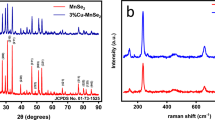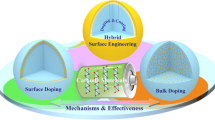Abstract
In this paper single band gap photo electrochemical cells (PECs) are presented, which consist of strontium titanate (SrTiO3) photo anodes on nickel cathodes in potassium hydroxide electrolyte. SrTiO3 powders are deposited on nickel substrates by electrophoresis before sintering with varying temperatures, times, cooling rates, gas types, and gas flow rates. The external quantum efficiency (EQE) of such PECs mainly depends on the morphology and the amount of oxygen vacancies in SrTiO3 lattice. At first, the morphology is investigated, which can be adjusted by the particle size as well as the sinter temperature and time. Nanopowder-based PECs sintered above the starting sinter temperature indicate the best charge carrier transport and hence allow high EQEs. The sinter time influences the specific surface area, but not the EQE in this investigation. Secondly, the generation of oxygen vacancies is investigated, which depends on the oxygen partial pressure and the equilibration temperature. Low oxygen partial pressures and high equilibration temperatures increase the amount of oxygen vacancies, which can be set by the gas type and its flow rate or the cooling rate and an additional heating step, respectively. It can be shown that PECs have to possess a low amount of oxygen vacancies to reach high EQE values, but not too low to allow for sufficient conductivity. This point is shown through our finding that the samples with lower and higher concentrations exhibit very low photo activity. Oxygen vacancies can be considered as intrinsic donors and hence increase electrical conductivity which is necessary but also act as recombination centers. For SrTiO3 nanopowder-based samples, which have been sintered at 1200 °C for 20 min with a cooling rate of 10 K/s in reducing gas (with 5 vol% H2) and a low flow rate of 1.7 l/h, very high external quantum efficiencies of 64.2 % under 365 nm illumination can be achieved.









Similar content being viewed by others
References
Walter MG, Warren EL, McKone JR, Boettcher SW, Mi Q, Santori EA, Lewis NS (2010) Solar water splitting cells. Chem Rev 110:6446–6473
Sabio EM, Chamousis RL, Browning ND, Osterloh FE (2012) Photocatalytic water splitting with suspended calcium niobium oxides: why nanoscale is better than bulk—a kinetic analysis. J Phys Chem C 116:3161–3170
Wu S et al (2008) Enhancement in dye-sensitized solar cells based on MgO-coated TiO2 electrodes by reactive DC magnetron sputtering. Nanotechnology 19:215704
Bockris J, Itho K (1984) Stacked thin film electrode from iron oxide. J Appl Phys 56:874–876
Hida Y, Kozuka H (2005) Photo anodic properties of sol–gel-derived iron oxide thin films with embedded gold nanoparticles: effects of polyvinylpyrrolidone in coating solutions. Thin Solid Films 476:264–271
Mori R, Takahashi K, Yoko T (2005) Photoelectrochemical and photocatalytic properties of multilayered TiO2 thin films with a spinodal phase separation structure prepared by a sol–gel process. J Mater Res 20:121–127
Karn RK, Srivastava ON (1998) On the structural and photochemical studies of In2O3-admixed nanostructured TiO2 with regard to hydrogen production through photoelectrolysis. Int J Hydrog Energy 23:439–444
Wrighton MS, Ellis AB, Wolczanski PT, Morse DL, Abrahamson HB, Ginley DS (1976) Strontium titanate photoelectrodes. Efficient photoassisted electrolysis of water at zero applied potential. J Am Chem Soc 98:2774–2779
de Kreuk CW, de Groot JLB (1981) Photocorrosion of strontium titanate photoanodes. Sol Energ Mater 5:437–444
Marozau I et al (2009) Optical properties of nitrogen-substituted strontium titantate thin films prepared by pulsed laser deposition. Materials 2:1388–1401
Jia A, Su Z, Lou L, Liu S (2010) Synthesis and characterization of highly-active nickel and lanthanum co-doped SrTiO3. Solid State Sci 12:1140–1145
Ashokkumar M (1998) An overview on semiconductor particulate systems for photoproduction of hydrogen. Int J Hydrog Energy 23:427–438
Maruska HP, Ghosh AK (1979) A study of oxide-based heterostructure photoelectrodes. Sol Energ Mater 1:411–429
Matsumura M, Hiramoto M, Tsubomura H (1983) Photoelectrolysis of water under visible light with doped SrTiO3 electrodes. J Electrochem Soc 130:326–330
Mavroides JG, Kafalas JA, Kolesar DF (1976) Photoelectrolysis of water in cells with SrTiO3 anodes. Appl Phys Lett 28:241–243
Yoon KH, Kim TH (1987) Photoeffects in undoped and doped SrTiO3 ceramic electrodes. J Solid State Chem 67:359–363
Shuk P, Jantz R, Guth H-U (2012) Oxygen sensors with advanced oxide electrode materials. Int J Smart Sens Intell Syst 5:233–245
Brailsford AD, Yussouff M, Logothetis EM (1997) A first-principles model of zirconia oxygen sensor. Sensor Actuat 44:321–326
Walters LC, Grace RE (1967) Formation of point defects in strontium titanate. J Phys Chem Solids 28:239–244
Eades WD, Swanson RM (1985) Calculation of surface generation and recombination velocities at the Si–SiO2 interface. J Appl Phys 58:4267
Hertkorn D, Elsenheimer HC, Bruch R, Paul F, Müller C, Hanemann T, Reinecke H (2013) Thickness variation of electrophoretically deposited strontium titanate films for photo electrochemical H2 generation. J Appl Phys 114(2):027020
Neville RC (1995) Solar energy conversion: the solar cell, 2nd edn. Elsevier, New York
Kelzenberg MD, Boettcher SW, Petykiewicz JA, Turner-Evans DB, Putnam MC, Warren EL, Spurgeon JM, Briggs RM, Lewis NS, Atwater HA (2010) Enhanced absorption and carrier collection in Si wire arrays for photovoltaic applications. Nat Mater 9:239–244
Moos R, Härdtl KH (1997) Defect chemistry of donor-doped and undoped strontium titanate ceramics between 1000 and 1400 °C. J Am Ceram Soc 10:2549–2562
Waser R (1991) Bulk conductivity and defect chemistry of acceptor-doped strontium titanate in the quenched state. J Am Ceram Soc 74:1934–1940
Moulson AJ, Herbert JM (2003) Electroceramics: materials, properties, applications, 2nd edn. John Wiley & Son Ltd, New York
Albery WJ, O’Shea GJ, Smith AL (1996) Interpretation and use of Mott–Schottky plots at the semiconductor/electrolyte interface. J Chem Soc Faraday Trans 92(20):4083–4085
Gomes WP, Cardon F (1962) Electron energy levels in semiconductor electrochemistry. Prog Surf Sci 12(2):155–216
Green MA (1982) Solar cells, operating principles, technology, and system applications. Prentice-Hall Inc., Englewood Cliffs
Hagfeldt A, Grätzel M (1995) Light-induced redox reactions in nanocrystalline systems. Chem Rev 95:49
Acknowledgements
The authors would like to thank the German Research Foundation (DFG—Deutsche Forschungsgemeinschaft) for their financial support within the graduate school “Micro Energy Harvesting” (GRK 1322/2) and M. Offermann for her technical support.
Author information
Authors and Affiliations
Corresponding author
Rights and permissions
About this article
Cite this article
Hertkorn, D., Benkler, M., Gleißner, U. et al. Morphology and oxygen vacancy investigation of strontium titanate-based photo electrochemical cells. J Mater Sci 50, 40–48 (2015). https://doi.org/10.1007/s10853-014-8563-y
Received:
Accepted:
Published:
Issue Date:
DOI: https://doi.org/10.1007/s10853-014-8563-y




